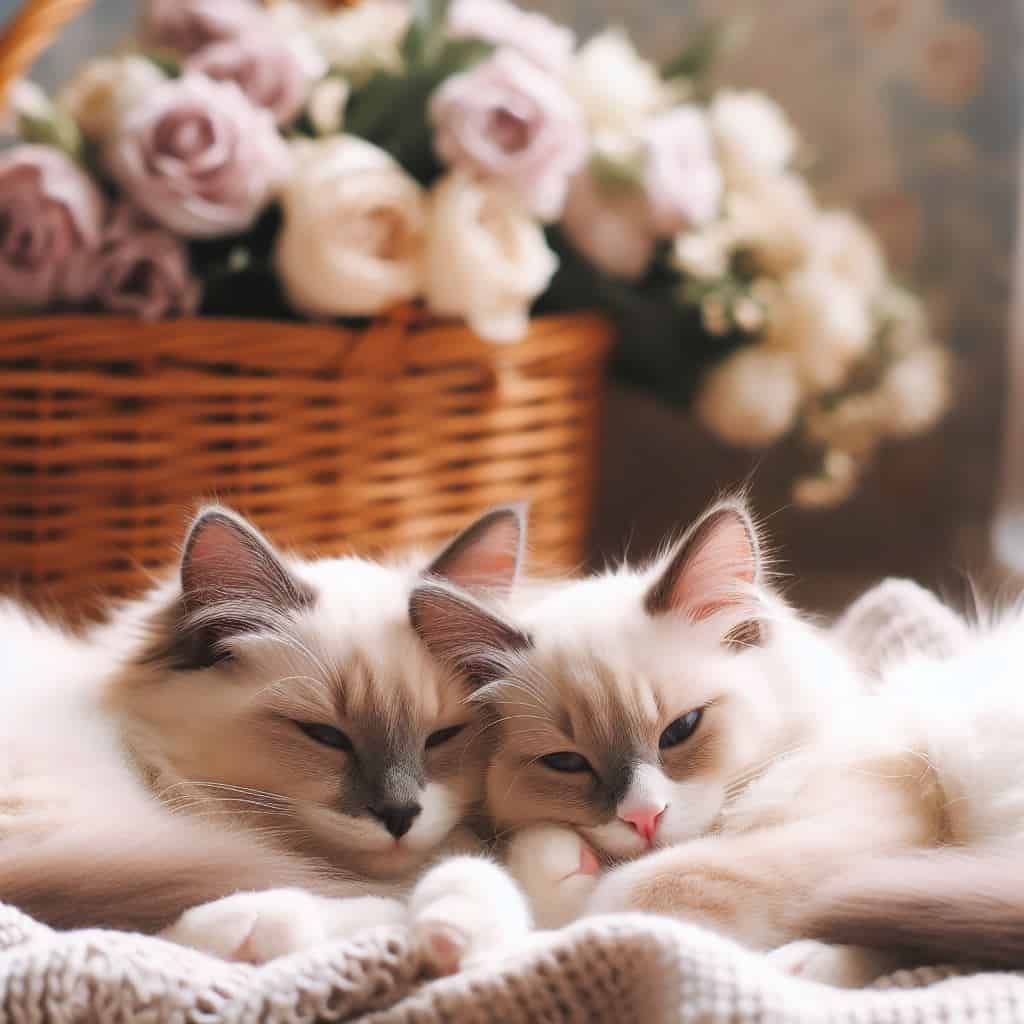Ragdoll cats are a popular breed known for their striking blue eyes, silky fur, and docile temperament. They were first developed in the 1960s by a breeder named Ann Baker in Riverside, California. The breed’s name comes from their tendency to go limp when picked up, similar to a ragdoll toy. Ragdolls are a relatively new breed compared to others, but they have quickly gained popularity for their unique characteristics. Today, let’s explore one of the most asked questions by the Ragdoll cat owners: “How old do Ragdoll cats live?”
Ragdoll cats typically live between 12 to 17 years, with proper care and a healthy lifestyle potentially extending their lifespan.
Ragdolls are large cats with semi-long hair and a muscular build. They have a soft and silky coat that comes in a variety of colors and patterns, including seal, blue, chocolate, lilac, and more. Their most distinctive feature is their striking blue eyes, which are almond-shaped and expressive. Ragdolls have a gentle and affectionate nature, making them excellent companions for families and individuals alike.
The Growth and Development of Ragdoll Kittens
Ragdoll kittens go through several stages of growth and development before reaching adulthood. Like all kittens, they are born blind and deaf and rely on their mother for nourishment and care. Around two weeks of age, their eyes begin to open, and they start exploring their surroundings. By four weeks, they start eating solid food and become more independent.
Proper care and nutrition are crucial during the kitten stage to ensure healthy growth. Ragdoll kittens should be fed a high-quality kitten food that is specifically formulated for their nutritional needs. It is important to provide them with plenty of fresh water and clean litter boxes. Regular veterinary check-ups are also essential to monitor their growth and address any health concerns.
The Adolescent Years: Ragdoll Cats in Their Prime
During adolescence, Ragdoll cats go through physical and behavioral changes as they transition from kittens to adults. They experience a growth spurt during this time, with males typically reaching their full size around three years of age and females around two years. Their coat also becomes denser and more luxurious.
Behaviorally, adolescent Ragdolls may become more independent and assertive. They may test boundaries and engage in more active play. It is important to provide them with plenty of mental and physical stimulation during this stage to prevent boredom and destructive behavior. Training and socialization are also crucial during this time to ensure they grow into well-behaved adult cats.
Understanding the Adult Years of Ragdoll Cats
As Ragdoll cats reach adulthood, their personalities become more stable, and they settle into their routines. They are known for their calm and laid-back nature, making them excellent companions for individuals or families. Adult Ragdolls are typically affectionate, gentle, and enjoy being around people.
Health considerations become more important during the adult years. Regular veterinary check-ups are essential to monitor their overall health and address any potential issues. It is also important to provide them with a balanced diet that meets their nutritional needs. Ragdolls are prone to obesity, so portion control and regular exercise are crucial to maintain a healthy weight.
The Senior Years of Ragdoll Cats: What to Expect
As Ragdoll cats enter their senior years, they may start showing signs of aging. These can include decreased mobility, changes in appetite, dental issues, and changes in behavior. It is important to provide them with extra care and accommodations during this stage to ensure their comfort and well-being.
Senior Ragdolls may benefit from a diet that is specifically formulated for older cats. Regular veterinary check-ups become even more important to monitor their health and address any age-related issues. Providing them with a comfortable and quiet space where they can rest is also crucial.
Common Health Issues in Ragdoll Cats
While Ragdoll cats are generally healthy, there are some genetic predispositions and health concerns that are more common in the breed. These can include hypertrophic cardiomyopathy (a heart condition), polycystic kidney disease, and bladder stones. It is important to be aware of these potential health issues and work closely with a veterinarian to monitor and manage them.
Symptoms of these health issues can vary but may include lethargy, decreased appetite, difficulty breathing, and changes in litter box habits. If any of these symptoms are observed, it is important to seek veterinary care promptly. Treatment options will depend on the specific condition and may include medication, dietary changes, or surgery.
Nutrition and Exercise for Ragdoll Cats of All Ages
Proper nutrition and exercise are crucial for the overall health and well-being of Ragdoll cats at all stages of life. They should be fed a balanced diet that is appropriate for their age and activity level. High-quality cat food that is specifically formulated for Ragdolls or other large breeds is recommended.
Portion control is important to prevent obesity, which can lead to various health issues. It is also important to provide them with regular exercise and mental stimulation. Interactive toys, scratching posts, and playtime with their owners can help keep them physically and mentally active.
Grooming and Coat Care for Ragdoll Cats
Ragdolls have a semi-long coat that requires regular grooming to keep it looking its best. They have a soft and silky fur that does not mat easily but still requires attention. Regular brushing helps remove loose hair and prevents matting. A stainless steel comb or a slicker brush can be used to gently brush their coat.
Bathing is generally not necessary unless they get particularly dirty or have skin issues. However, regular nail trims, ear cleaning, and dental care are important parts of their grooming routine. It is also important to check their eyes regularly for any signs of irritation or infection.
Behavioral Changes in Ragdoll Cats as They Age
As Ragdoll cats age, they may experience changes in behavior and temperament. They may become less active and more sedentary, preferring to spend their time napping or lounging. They may also become more vocal or clingy, seeking more attention and companionship.
It is important to be patient and understanding with senior Ragdolls and provide them with the care and attention they need. They may benefit from a quiet and comfortable environment where they can rest undisturbed. Providing them with plenty of mental stimulation, such as interactive toys or puzzle feeders, can also help keep their minds active.
Caring for Your Ragdoll Cat Throughout Their Lifespan
Providing lifelong care and companionship to your Ragdoll cat involves several key considerations. Regular veterinary check-ups, a balanced diet, proper grooming, and plenty of love and attention are all important aspects of their care. It is also important to be aware of any potential health issues that are common in the breed and work closely with a veterinarian to monitor and manage them.
Ragdolls thrive on human companionship and enjoy being part of a family. They are gentle and affectionate cats that make excellent companions for individuals or families. Providing them with a safe and comfortable environment, regular exercise, mental stimulation, and plenty of love will ensure they live a happy and fulfilling life.
There are many resources available for Ragdoll cat owners who want to learn more about the breed or seek support. Online forums, breed-specific websites, and local Ragdoll cat clubs can provide valuable information and connect owners with other enthusiasts. It is important to stay informed and educated about the breed to provide the best possible care for your Ragdoll cat.
Originally posted 2023-09-04 03:15:35.
Johny is a dedicated pet enthusiast, author, and the driving force behind the insightful content at PetSWAT. With a deep passion for animals and a wealth of knowledge acquired through years of experience, Johny brings a unique perspective to the world of pet care and companionship.



